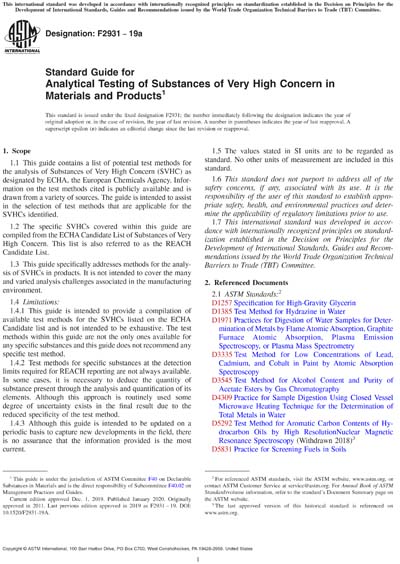Most recent
ASTM F2931-19a
Standard Guide for Analytical Testing of Substances of Very High Concern in Materials and Products
1.1 This guide contains a list of potential test methods for the analysis of Substances of Very High Concern (SVHC) as designated by ECHA, the European Chemicals Agency. Information on the test methods cited is publicly available and is drawn from a variety of sources. The guide is intended to assist in the selection of test methods that are applicable for the SVHCs identified.
1.2 The specific SVHCs covered within this guide are compiled from the ECHA Candidate List of Substances of Very High Concern. This list is also referred to as the REACH Candidate List.
1.3 This guide specifically addresses methods for the analysis of SVHCs in products. It is not intended to cover the many and varied analysis challenges associated in the manufacturing environment.
1.4 Limitations:
1.4.1 This guide is intended to provide a compilation of available test methods for the SVHCs listed on the ECHA Candidate list and is not intended to be exhaustive. The test methods within this guide are not the only ones available for any specific substances and this guide does not recommend any specific test method.
1.4.2 Test methods for specific substances at the detection limits required for REACH reporting are not always available. In some cases, it is necessary to deduce the quantity of substance present through the analysis and quantification of its elements. Although this approach is routinely used some degree of uncertainty exists in the final result due to the reduced specificity of the test method.
1.4.3 Although this guide is intended to be updated on a periodic basis to capture new developments in the field, there is no assurance that the information provided is the most current.
1.5 The values stated in SI units are to be regarded as standard. No other units of measurement are included in this standard.
1.6 This standard does not purport to address all of the safety concerns, if any, associated with its use. It is the responsibility of the user of this standard to establish appropriate safety, health, and environmental practices and determine the applicability of regulatory limitations prior to use.
1.7 This international standard was developed in accordance with internationally recognized principles on standardization established in the Decision on Principles for the Development of International Standards, Guides and Recommendations issued by the World Trade Organization Technical Barriers to Trade (TBT) Committee.
Content Provider
ASTM International [astm]






